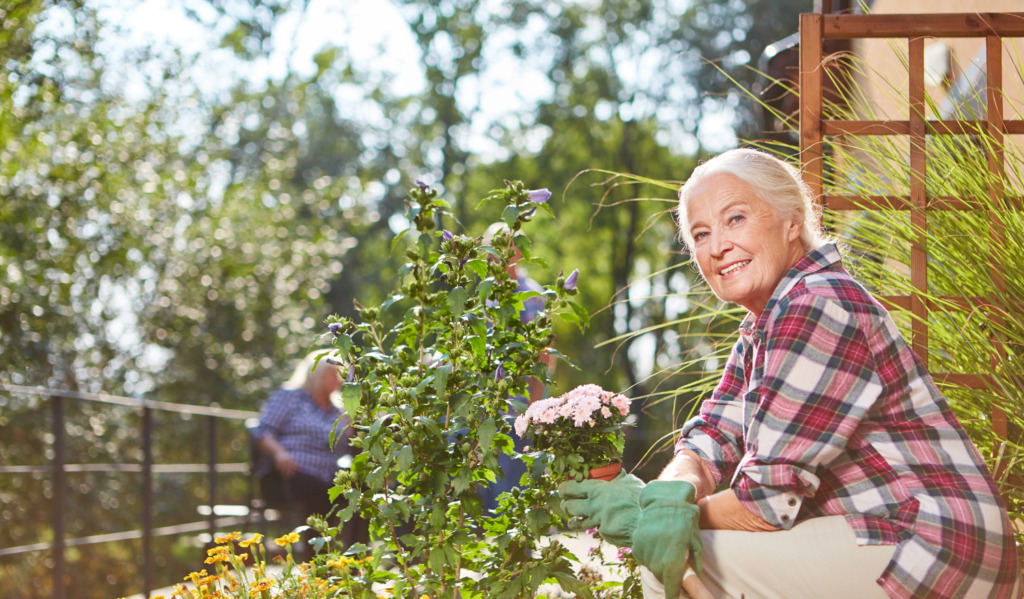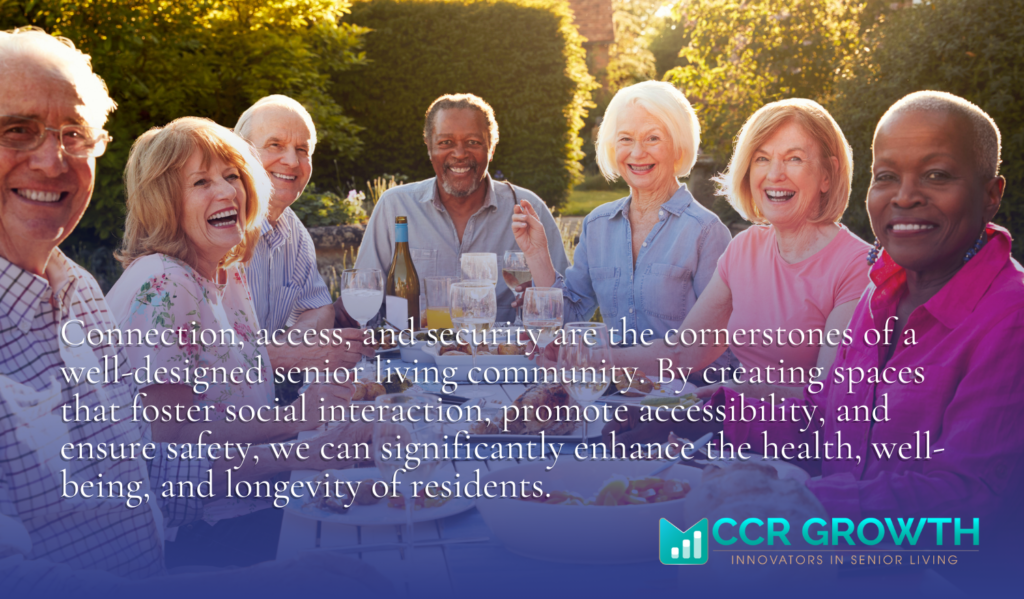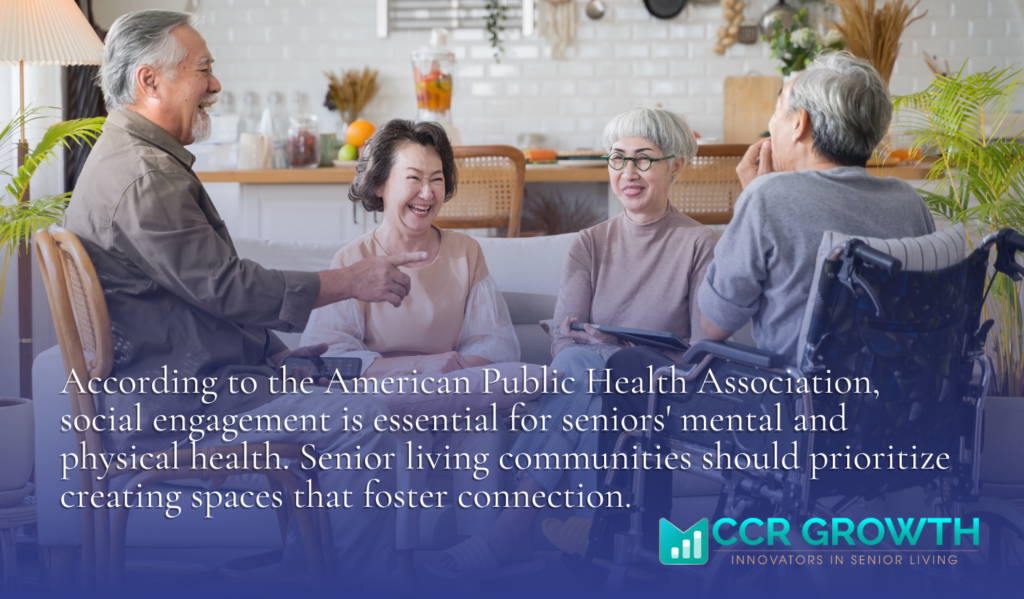
CCR Growth
How The Built Environment Can Impact Resident Wellness in Senior Living Communities
Our environments – the physical places we live and interact with others in – directly impact our health and well-being. So much so, that the layout and design of our homes and the common spaces we spend time in such as parks and other public spaces has become an area of study. When it comes to senior living communities, design plays a significant role in achieving a supportive and enriching environment for residents. In this article, we’ll be taking a closer look at how the built environment can be best used to ensure a thriving senior living community. According to the Collaborative for Health and Environment (CHE), the built environment is “the human-made physical spaces where we live, recreate and work. These include our buildings, furnishings, open and public spaces, roads, utilities and other infrastructure. These structures and spaces affect our health by bringing pollutants into our environments and by allowing or restricting access to physical activity, transportation and social interactions.”

The Impact of Design on Resident Engagement
Research consistently illustrates the relationship between building design and the level of physical and social participation of older adults in activities such as exercising. Well-designed spaces can encourage physical activity and foster interaction among residents to ultimately increase quality of life overall. In a research paper entitled Promising Aging in Community Models in the U.S, authors Su-I Hou and Xian Cao define the ideal environment: “A supportive environment for aging in the community can be any natural or intentionally designed community that supports older adults’ various health and social needs, including access to health services, meal services, housekeeping, transportation, and social activities.
The environment should incorporate aging and universal design with barrier-free physical features such as handlebars in bathrooms and wheelchair ramps (Park et al., 2017). The services or activities should be available at an easily accessible distance or accessible via public transportation (Geboy et al., 2012; Lavery, 2015). Last but not least, affordable housing options for older adults with different needs should be available.” According to the authors, the concept of aging in community (AIC) emphasizes the significance of creating environments which cultivate such supportive environments to “intentionally encourage older adults to form mutually supportive relationships that promote quality of life and a sense of community”. In other words, AIC models aim to ensure older adults remain independent while being engaged within their local communities. A 2010 study found that those in naturally occurring retirement communities (NORC) were less likely to need nursing home care compared to the national average.
A significant characteristic of this model is that the older adults remain key decision-makers in the community, helping to steer its overall management. While this is not a typical aspect of the traditional senior living community model, it is worthwhile to consider that involving your residents’ in decision-making might enhance their health and well-being through creating a sense of purpose and an avenue through which to direct their energy. It may also ensure your community design and service offerings are more properly suitable to your residents given that residents themselves may have been instrumental in choosing them.
This highlights the importance of person-environment fit – that is to say ensuring environments meet resident needs regardless of any personal limitations. Researchers conducting an analysis on community models for older adults in the US have revealed three main themes related to optimizing the built environment to encourage better engagement: connection, access and security. By designing spaces which promote these three main elements, senior living communities can significantly enhance residents’ health, well-being and longevity.

How Active Aging Factors into Built Environment
Active aging, a holistic approach to aging that emphasizes physical, mental, social, and spiritual well-being, is increasingly recognized as essential for enhancing quality of life and independence. The built environment plays a critical role in supporting active aging by creating spaces that encourage engagement, promote physical activity, and foster a sense of community. Some of the factors to consider when designing environments based on AIC and Active Aging principles:
- Accessibility: Ensure that all spaces are accessible to residents with disabilities, including those with mobility limitations, visual impairments, or hearing loss. This involves incorporating features such as ramps, elevators, and grab bars.
- Universal Design: Design spaces with flexibility in mind, allowing for easy adaptation to changing needs. This includes features like adjustable countertops, lever-style door handles, and ample lighting. Universally designed spaces aim to accommodate people of all ages and abilities to ensure an inclusive and welcoming environment for all.
- Social Engagement: Create spaces that foster social interaction and community building to foster a sense of belonging. This can include common areas, courtyards, and activity rooms.
- Physical Activity: Incorporate opportunities for physical activity, such as walking paths, fitness centers, and outdoor exercise equipment.
- Mental Stimulation: Provide spaces for intellectual engagement, such as libraries, computer labs, and adult education programs.
- Biophilic Design: Integrate natural elements, such as plants, gardens, and courtyards, to promote relaxation and well-being, while reducing stress.
- Aging-in-Place Design: Incorporating features that allow residents to remain independent as their needs change over time.
Read: Why Active Aging Is a Critical Part Of Modern Senior Living
Intergenerational Living as an Aspect of Design
Intergenerational living offers a multitude of benefits for both older adults and younger generations. By fostering connections across age groups, these communities create a vibrant and supportive environment. Older adults can benefit from the energy and perspective of younger individuals, while younger people can gain valuable life lessons and a sense of purpose. Intergenerational living can also reduce feelings of loneliness and isolation, promote social engagement, and create a more diverse and inclusive community. An example of how you might incorporate intergenerational living in practice could look like this:
A senior living community could partner with a nearby university to create an intergenerational program. Students could volunteer to assist residents with tasks, provide companionship, or teach them new skills. In return, residents could share their wisdom and life experiences with the students. This type of collaboration would create a mutually beneficial relationship and foster a sense of community for all involved.
Emerging Design Trends in Senior Housing

The senior living industry is constantly evolving, with new trends emerging to meet the changing needs of residents. Here are some key trends for 2024 released by Environments for Aging magazine:
- Nature-Inspired Color Palettes: Using earthy tones and natural hues to create a calming and inviting atmosphere.
- Art Deco Revival: Incorporating bold geometric patterns and luxurious materials to add a touch of sophistication and an element of nostalgia from a bygone era.
- Biophilic Design: Integrating natural elements to enhance well-being and create a connection to the outdoors.
- Robotics and Technology: Utilizing AI and robotics to streamline operations, freeing up your staff contingent to better meet the needs of your residents.
Wrap-Up
Imagine a senior living community that’s a vibrant ecosystem supporting the physical, mental, social, and spiritual well-being of its residents. Where residents can easily access a variety of amenities, from fitness centers to a vibrant community garden. The community’s design encourages social interaction, with ample common spaces and opportunities for group activities. Residents have access to on-site medical care, transportation services, and a variety of social programs, some of which are integrated into the wider community beyond the walls of the senior living space and which encourage intergenerational interaction. This community exemplifies how a well-designed built environment can support active aging and enhance the quality of life for its residents.
The built environment plays a pivotal role in shaping senior living communities’ overall experience for residents. By prioritizing their resident well-being and creating supportive spaces to meet emerging trends, communities can foster an atmosphere that empowers older adults to live a full and wonderful life. Need more high-quality leads for your senior living community? Our team at CCR Growth can help. We tailor our marketing strategies to your unique needs. Contact us today.
Subscribe to our newsletter
Sharpen your expertise and stay ahead of senior living industry trends—subscribe to CCR Growth’s newsletter for exclusive insights and updates.
Recent Posts



A Complete Guide to Generative Engine Optimization for Senior Living
Redefining Senior Living Marketing, Sales, and Operations
CONTACT ADDRESS
8710 Carmel Valley Road, Carmel, CA 93923
GENERAL INQUIRIES
info@ccrgrowth.com
(831) 273-3628
SOCIAL MEDIA




